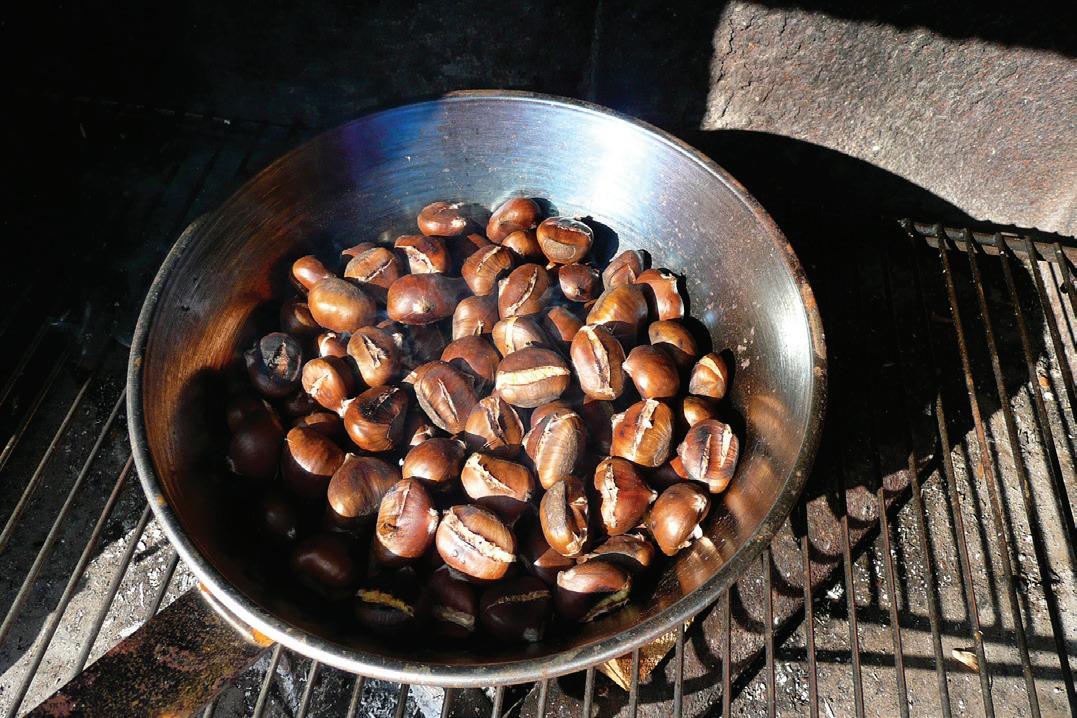
3 minute read
November in Sicily: Saint Martin Festivals and Chestnuts!
By Alberto Lunetta NAS Sigonella Public Affairs

Fall is known for “caldarroste” or roasted chestnuts, and the best way to eat them is when they are warm. You can sample them at city street corners or at one of the many fall Saint Martin’s festivals celebrating the Roman soldier who became a saint for living a holy and humble life.
(Stock photo)
Advertisement
Fall continues to be in full swing in Sicily, and freshly roasted chestnuts known as “caldarroste” are roasted daily on traditional brown smoker pans that are located in every street’s corner, filling the neighborhood with clouds of smoke and aroma. The fall is when the chestnuts are ripe and ready to be cooked into different recipes. One of the best ways to eat them is to buy them freshly roasted! They are perfect for cold winter evenings.
Roasted chestnuts are cooked with salt on special pans with holes. Chestnuts are cut on the rounded side to avoid popping during cooking and then roasted until the peel becomes whitish. The custom of eating chestnuts dates back to ancient Roman times, when castagne were considered as food for the aristocracy. A famous chef from Imperial Rome prepared them with a pepper sauce and other spices. In the Middle Ages and following centuries, chestnuts progressively became the staple food of Italian peasants.
Chestnuts are easy to find in the woods and rich in potassium. For centuries they helped the population to survive during famine. During wars, Medieval and Renaissance European armies would store chestnut flour because it can be preserved for a long time and used as a bread substitute. In the 18th century, an Italian company from Piedmont created “Marron Glaces” which were chestnuts glazed with sugar syrup using the best, largest chestnuts known as “marroni.”
Today, chestnuts are prepared in many different ways and are a symbol of the upcoming Christmas season. A French chef suggested eating them roasted while sitting around a fire with friends and sipping a light wine such as “Beaujolais Nouveau.”
Chestnut and wine pairing is a typical offering at one of Italy’s most popular attractions in the fall: the “Estate di San Martino” or “Summer of St. Martin.” This is a festivity, falling during a period of unusually warm weather, similar to the Indian summer, which is celebrated on Nov.11.
The Summer of St. Martin is named after St. Martin of Tours and commemorates ancient wine racking techniques (the separation of wine from its sediment). During this period, farmers would visit each other to compare the products of the winemaking process and dine together with fresh bread, salami, cheese, and of course, “caldarroste.”
Legend has it that during a cold night in the 4th century (on Nov. 11), the Roman officer Martino, who later became a bishop and then a saint, rescued a beggar by giving him half of his cloak. As Martino was on his way back home, the weather suddenly changed to being beautifully warm!
Today, this festivity keeps alive the tradition of blending pagan (celebration of fertility, end of harvest and wine-making season etc.) and Christian (remembering the good heart of St. Martin) elements. Festivals are held in almost every town and city of the island. Make sure you visit them with your family!
Arancini Added to Prestigious Oxford English Dictionary
By Wanteinrome/Italymagazine
Arancini, the Sicilian deep-fried rice balls, has been added to the revised 2019 edition of the Oxford English Dictionary. Arancini, among 650 new words added to the dictionary, are defined as “rice balls with a savoury filling, covered with breadcrumbs and fried,” and are “typically served as antipasto or snack.”
The listing in the English dictionary has also reignited the spelling of the popular street food snack: Oxford chose the masculine version of the word “arancini,” native to Catania, over the feminine “arancine” as they are known in western Sicily including Palermo.
Arancini hail from the Catania region of eastern Sicily and are made in a conical shape reminiscent of the volcano Mount Etna. Arancini are said to have originated in 10thcentury Sicily at a time when the island was under Arab rule.
Arancini are stuffed with various fillings such as traditional ragù, peas, mozzarella or melanzane, but in recent years have included more creative and unexpected fillings including broccoli, spinach, pistachio or salmon, as well as vegetarian options.
Italian Police Bust Mafia Plastic Recycling Ring
By AFP
Italian authorities say they have smashed a Mafia-run plastic recycling ring that sent toxic material from Sicily to China. The scam was uncovered during a four-year investigation, after shoes made in China with the contaminated plastic were found on sale in Italy.
Police say 15 people were held on a range of offenses, including extortion and waste trafficking. Among them was alleged ringleader, Claudio Carbonaro. He had been a police witness at one stage, but in 2013 returned to Sicily and took over a feared Mafia syndicate. He then entered the highly lucrative trade in toxic plastics.
According to Italian police, Claudio Carbonaro was responsible for atrocious crimes in the 1980-90s, including over 60 murders. The arrests were made in and around the Sicilian city of Ragusa.








